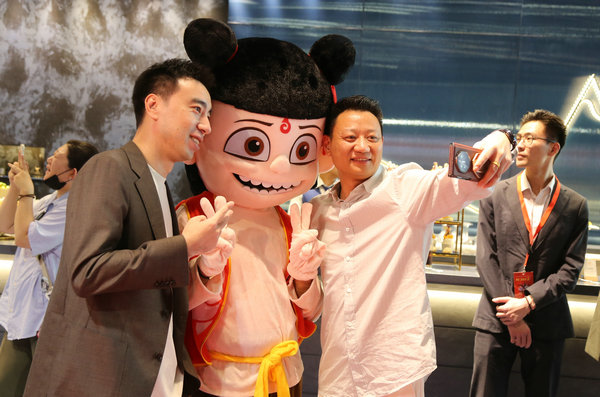Adapting is key to winning foreign audiences
Storyline must gel with overseas viewers to ensure success, according to Japan-based specialist, Jiang Xueqing reports in Tokyo.


In recent years, Chinese cultural appeal has shown encouraging momentum globally. Dong Zhiling, founder and president of Facewhite, a Tokyo-based film distribution company specializing in bringing Chinese films to Japanese audiences, stresses the importance of communicating stories in a language the audience can truly understand.
"Fundamentally, we have to speak in a way others can comprehend — just as you wouldn't speak Chinese to someone who's never studied it. No matter how eloquent or poetic your words are, they won't land if the listener doesn't understand them," Dong says.
He notes that part of the responsibility falls on creators, who must be mindful that deeply rooted Chinese concepts may need to be adapted in form or expression for overseas audiences to grasp. Without that consideration, international success becomes far more difficult.
Distributors, too, play a key role in bridging the gap, as they work to make these works accessible and relatable through thoughtful translation and strategic marketing.
Only when both sides — creators and distributors — work in tandem, Dong emphasizes, can Chinese culture find broader and more lasting acceptance abroad.
"Culture is a form of soft power; it can't be imposed. It must be introduced in ways that people are open to. That's the foundation — respect the local market, and respect the local audience," he says.
Earlier this year, the Chinese animated blockbuster Ne Zha 2 was released in Japan through Facewhite. Ahead of the screening, the Tokyo-based distributor compared three different Japanese subtitle versions, not only with input from industry professionals but also by gathering feedback from general audiences. The goal was to determine which translation best resonated with Japanese viewers while staying true to the film's original spirit.
Japanese viewers were particularly struck by the film's stunning computer-generated imagery and meticulous attention to detail.
Sara Takase, with human resources firm Tohoki, is deeply moved by the story: "The themes of family and friendship brought me to tears."
According to a Chinese film industry data provider, by the end of its theatrical run in the Chinese mainland on June 30, Ne Zha 2 had grossed over 15.9 billion yuan ($2.21 billion) worldwide, placing it fifth in the global box-office rankings.
Dong says he has witnessed a new generation of outstanding Chinese creators coming into their own. "Many of them grew up watching the world's best content. Now, in their prime, they've endured setbacks and gained valuable experience," he notes.
Dong emphasizes that animation is a capital-intensive industry, heavily influenced by the broader economic environment. "You need substantial funding to produce works at this scale, and beyond just creating them, there must be a market willing to pay for them. In recent years, the essential conditions — economic support, creative talent, and audience demand — have gradually matured. That maturity is now beginning to translate into truly remarkable works," he says.
Reflecting on his early days in animation, Dong recalls that more than a decade ago, animated films aimed at Chinese teenagers typically earned only tens of millions of yuan at the box office. Today, Ne Zha 2 has seen its global earnings, including presales, surpassing 15 billion yuan.
"This kind of breakthrough reveals that market demand was always there. It just wasn't being met," Dong says. "So when someone finally created a film that exceeded expectations, what followed was a wave of 'revenge consumption' driven by long-suppressed audience demand."
That surge of enthusiasm, he notes, is a powerful source of encouragement for those working in the industry. Many of the creators behind such hits are long-term thinkers who have weathered years of challenges — overcoming doubt, hardship, and lack of recognition — before finally delivering something remarkable.
"And the reason they're able to succeed now," Dong adds, "is because the environment has become more supportive. The entire industry ecosystem, along with the broader national context, is now making it possible for these visions to be realized".
Addressing the challenges faced by culturally rich Chinese films in Japan, Dong emphasizes the complexity of cross-cultural storytelling.
"Chinese cultural elements can feel fresh and intriguing, but they also carry the risk of unfamiliarity," he says. "It's like how Japanese people love Chinese food, but the version they enjoy often tastes quite different from authentic Chinese cuisine. That's the kind of cultural nuance we have to navigate with care."
He observes that Chinese films that perform well in Japan tend to be those with themes or cultural aspects that Japanese audiences can easily relate to or understand. When those elements resonate, the reception is often very positive.
"But if certain components — while meaningful or iconic for Chinese viewers — are difficult for Japanese audiences to grasp, the response may fall flat," Dong explains. "When used well, Chinese cultural elements can give a film a distinctive voice and help it stand apart from Hollywood or Japanese productions. That's the upside. The risk, however, is that if local viewers don't connect with these elements, they can become a barrier to marketing and promotion."

The key, he emphasizes, lies in striking the right balance: maximizing the appeal of Chinese cultural elements while minimizing potential friction. That is the part film distributors are both excited and cautious about.
At Facewhite, this balancing act plays out daily in the marketing and distribution process. The company is constantly experimenting, learning and refining its strategies. With every project constrained by limited time, funding, and resources, decisions about how to engage viewers, structure promotional campaigns, and choose the right release window can make a decisive difference in a film's success.
Dong highlights one of the major obstacles in bringing Chinese-language films to Japanese audiences: a recurring vicious cycle.

"Historically, Chinese films haven't performed strongly at the Japanese box office," he explains. "Because of that, budgets for subsequent releases remain limited. With smaller budgets, it becomes difficult to properly execute marketing, localization, or distribution strategies — resulting in continued under-performance. And so the cycle repeats."
Breaking this deadlock, he emphasizes, requires raising commercial expectations. But it demands tackling two challenges simultaneously: better localizing Chinese-language films for the Japanese market, and improving the overall business model through smarter planning and promotion.
Dong also cautions against a narrow focus on traditional Chinese literary adaptations like Investiture of the Gods or Romance of the Three Kingdoms. "Audiences will eventually suffer from aesthetic fatigue," he says. "The cultural industry thrives on innovation. Even the most successful formula will stop working if it's repeated too often."
Instead, he advocates for storytelling that draws from tradition while offering something new. "A better path forward is to create original narratives infused with the essence of Chinese culture," Dong says. "To reach today's younger audiences, we need to use contemporary storytelling methods to communicate timeless cultural themes."
On Wednesday, Facewhite announced that the sequel to the beloved Chinese animated film The Legend of Hei is officially slated for theatrical release in Japan on Nov 7. Both Japanese-dubbed and subtitled versions will be available in cinemas.





































